I’ve always come to the science of horse training from the empiric perspective, meaning I learn it from a practical standpoint first, usually only discovering its scientific significance later. Over the years, I’ve had many behavioralists and mental health care professionals attend my clinics, where they described some horse training methods I used as titration or successive approximation. They then explained the science behind desensitizing methods I have been applying for years.
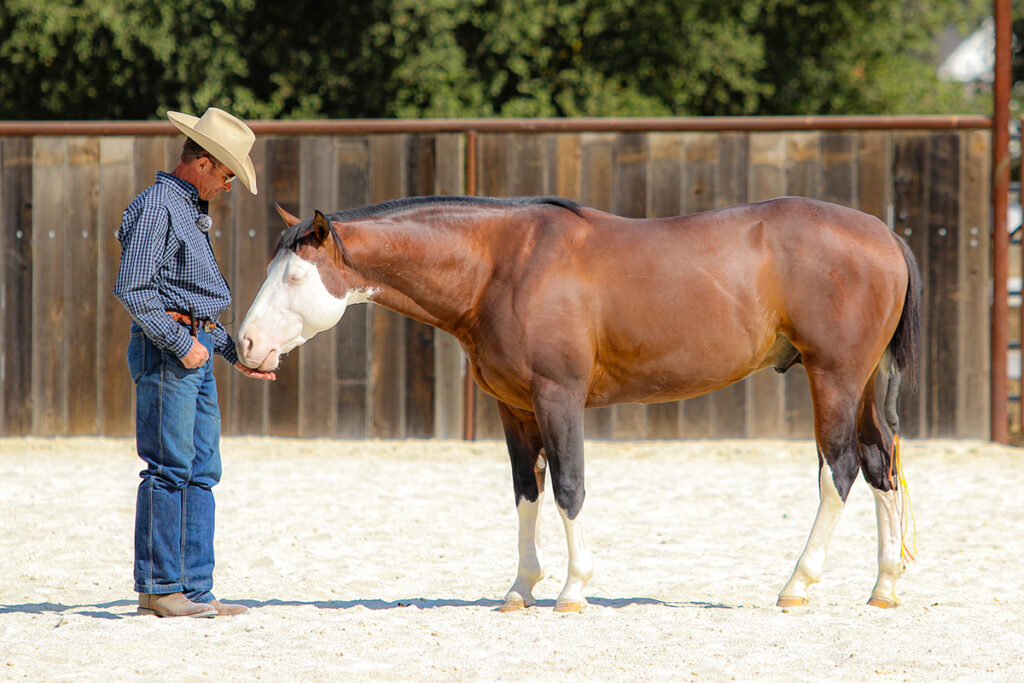
A New Desensitizing Method
In the past few years, I have vastly changed the way I train horses. I now choose to focus on building a relationship before attempting any sort of training, which I have heard referred to as “connection before concepts.” In the past, I managed to build trust and relationships because of the consistency of the training I was implementing, but now I focus on the connection first. The results have been nothing short of amazing.
While trying to understand why this new way of training was working so well for me, I came across something called Poly-Vagal Theory (PVT). Poly means more than one, and vagal refers to the Vagus Nerve, which is the information superhighway between your abdomen, heart, and brain. PVT gives us a much better understanding of mammals’ Autonomic Nervous System (ANS), which consists of the Parasympathetic Nervous System and the Sympathetic Nervous System. The Parasympathetic is the system that slows down the heart rate and keeps your horse in the rest and digest state. This system is comparable to the brakes in your car, bringing you safely to a stop from an otherwise dangerous high speed. The Sympathetic Nervous System is all about activation and is comparable to the accelerator in your car. It’s the fight or flight state that allows mammals to effectively use energy to get out of dangerous situations. I used to think that one was on and the other one was off, but PVT has helped me realize there’s much more to it. Don’t be daunted by the scientific names—the concepts are simple yet illuminating.
Poly-Vagal Theory states there are two branches of the Parasympathetic Nervous System. They both help slow down the body, but they serve two entirely different functions. The Dorsal Vagal Complex concerns itself with immobility and could be compared to the parking brake in your car. It should only be applied when your car is already stopped, but it can also be applied forcefully in an emergency. Your horse uses this brake when he’s standing around dozing, grazing, or hanging out with his mates. In those cases, the brake is applied gently. Your horse can also use this brake to go into freeze mode. When your horse becomes highly worried and their other survival options, such as fight or flight, are not available or haven’t worked, he will initiate a freeze response.
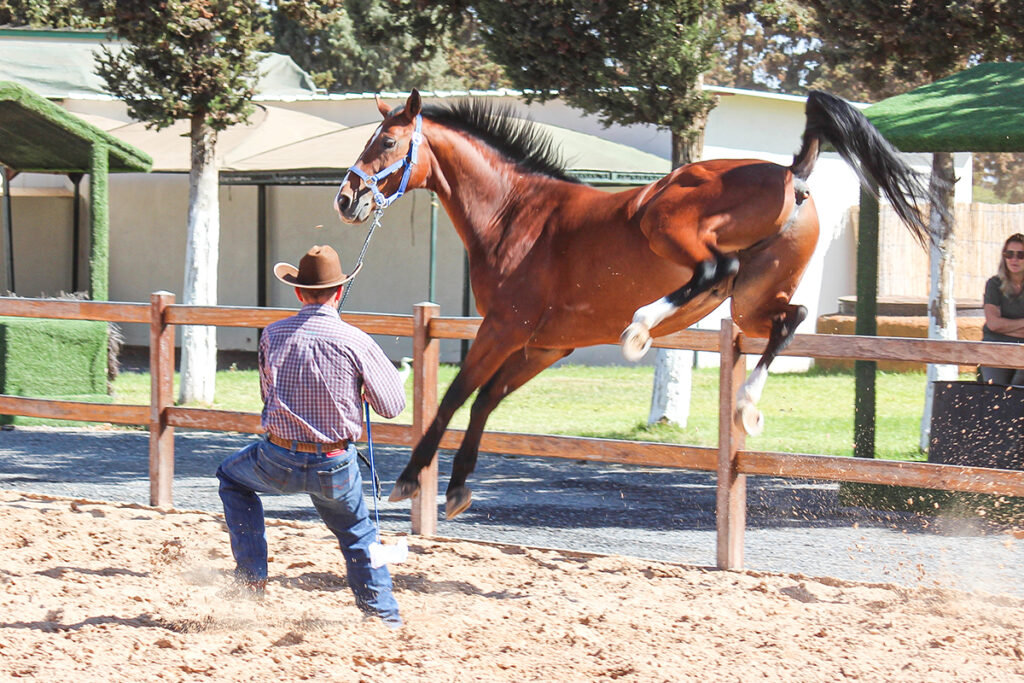
The other “brake” is the Ventral Vagal Complex, which pertains to relaxation brought on by social engagement. It’s about something called attunement which trauma therapist Sarah Schlotte describes as, “Being seen, being heard, feeling felt, and getting gotten.” Horses naturally share this attunement when in a herd. When this brake is engaged, a horse can be active and have energy, but also not be in a worried state. This is the state we’d like to have our horses in when we are riding. Whether you are headed out on the cross country course, setting up a passage during a dressage test, or in my case running wide open towards a sliding stop in the reining arena, your horse should be able to stay physically active while remaining mentally calm and connected to the rider. If we can use the Ventral Vagal brake in our training program, we create a horse who responds willingly.
Of course, all this training starts long before you begin riding your horse. First, we have to make the horse safe on the ground and desensitize them to sight, sound, and sensation. Horses that don’t receive much desensitizing and have an anxious personality tend to be labeled hot, fractious, or downright dangerous. All dangerous behaviors occur when a horse is in a high state of arousal, which means their Sympathetic Nervous System is running unchecked with no Parasympathetic brake to help bring them back down. Many horses like this end up with bigger bits, draw reins, an endless stream of calming supplements, and sometimes even sedation to slow down this activation. All these tools are replacements for a faulty Parasympathetic Nervous System. If we can strengthen and train the PNS to easily relax our horses the moment they get too uptight or tense, we can bring them back down to the rest and digest state where no dangerous behaviors occur.
When we work with our horses, we constantly use some form of the brake. I’m going to go through some common and some not-so-common desensitization techniques and describe which of these brakes is used in each instance. I’ll also describe different ways of desensitizing a horse to a flag (a piece of cloth or plastic bag on a stick), and in this case, we’ll assume the horse is sensitive and a little flighty. In a real scenario, how the horse has been handled up to this point makes a huge difference. In order to catch the horse and get the halter on, there would have been some form of brake applied, but we will just focus on the desensitization part for now.
Method 1: Old-School Desensitization
I’m going to start out old school, with the “tie them to a post, spider hobble them, and bag them down” trick. This technique, which is rarely used these days, involves tying a horse to an unbreakable post with an unbreakable halter and lead rope, and putting on a set of 4-way hobbles so the horse can’t move. Next, the handle would begin flapping a flag all over the horse, not stopping no matter how they reacted. Even when the horse stops, the handler continues flapping the flag all over them. The result is a horse that will stand still while you flap the flag all over them.
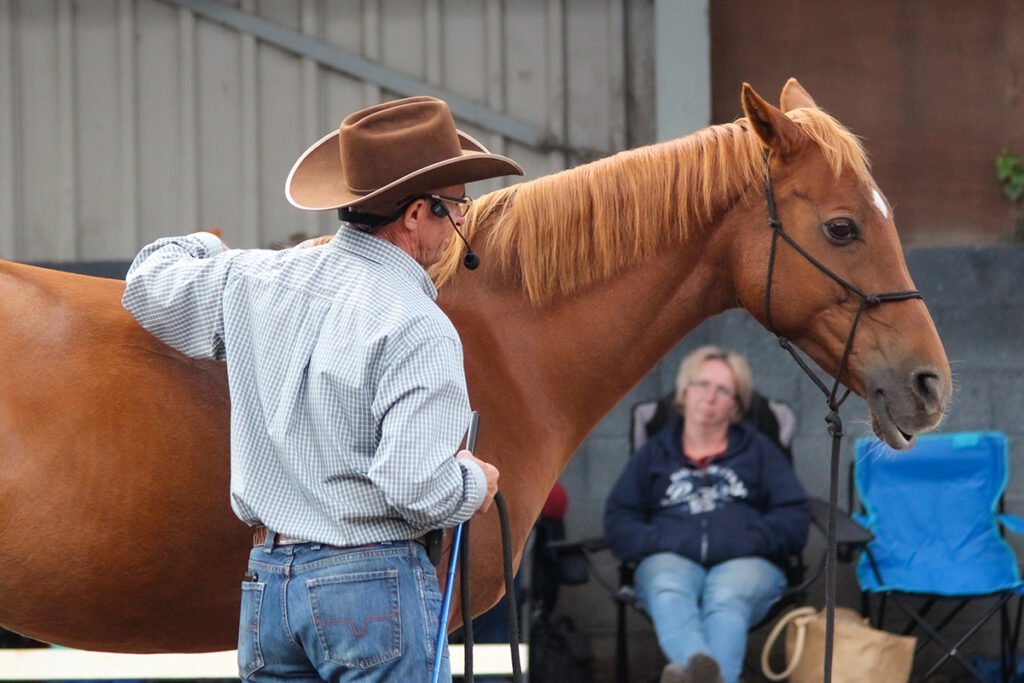
When a horse feels rising concern, they will immediately search for a friend before enacting any other response. If they are unable to find the herd security blanket, they will go into flight, fight, or freeze mode. As there are no friends in this situation, and the horse is unable to run away from or fight what is happening, they slam on the Dorsal Vagal brake and freeze. The horse is no longer present. They go internal and their body is flooded with chemicals that would allow them to be eaten alive with no sensation of it actually happening. This is also known scientifically as Learned Helplessness or Tonic Immobility. While the horse appears calm, they are not. They are beyond fear, beyond reactivity, and at the ultimate level of shut down. Many times, these horses later come out of that state with disastrous consequences resulting from trauma stored both in memory and the body.
Method 2: The Common Understanding of Desensitization
The next type of desensitizing I want to discuss is one that I am quite familiar with because I used this technique for years with great success. This technique works best for horses that may have multiple riders or handlers and just have to do their job. It involves having the horse in a halter and lead, holding the lead with the left hand about half a yard from the halter, with the flag in the right hand. You bring the flag around towards the near side of the horse and allow him to move if he was concerned. If the horse moves, keep the flag the same distance from him as it was when he first started to move, following him around until he stopped. Then immediately take the flag away. The flag may have been only one or two yards from the horse before he started to move.
In this method, the horse tries to run away from the flag, but that doesn’t work, so the horse stops in a freeze. So, the hand brake is applied, but not very forcefully because the social engagement brake is also engaged. The social engagement brake is engaged because as the horse gets concerned about the approaching flag and moves, you don’t bring it any closer to him, but instead follow him with it. This gives him a sense of being seen. The same thing happens when he stops, and you take the flag away. That also communicates that you are aware of what’s going on, as opposed to the previous method of flapping the flag no matter what happens. Taking away the pressure of the flag as the horse stops is also rewarding them for finding the right answer. Like in the first method, the horse will eventually not care about the flag, but in this case, you have built some trust. However, you can continue to break down this process to become more refined and more empathetic towards how the horse feels.
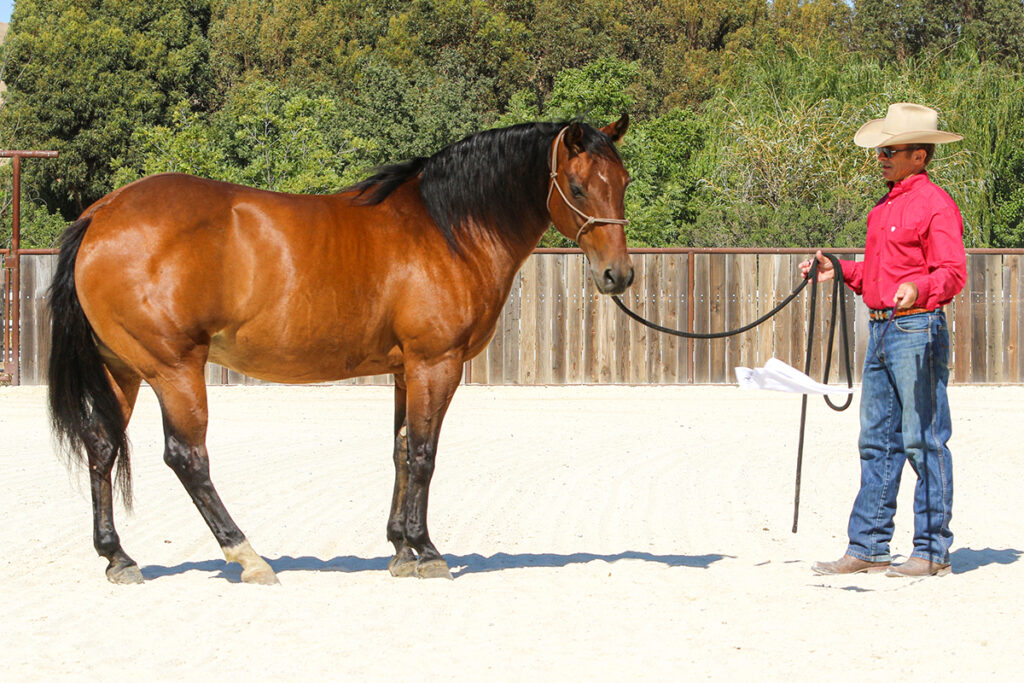
Method 3: The Empathetic Approach to Desensitization
The third method takes a slightly different approach. It starts off the same, bringing the flag towards the horse. If they felt the need to move away, you allow it, but at the same time remove the flag as soon as they begin to move. This process communicates to the horse that whenever they start to be uptight about something, you will be there to help dissipate that tension. You communicate to them that you are aware of their sense of security and are willing to take the steps needed to make them feel safer. This activates the social engagement brake, and, as time goes on, they allow the flag to get closer and closer. Usually, this technique replaces fear with curiosity, and the horse will actively seek to engage with the flag. This is the unintended benefit of this method: you can stir up enough curiosity to create a draw out of the same tool usually used to create drive.
Method 4: Using Subtle Signs Of Tension
The final technique is even more refined, and in my experience, works the best. In this method, you will closely observe the horse’s eyes, ears, and head posture before you do anything with the flag. It’s important to have that baseline established, because anything that varies from that behavior should be noted. As you approach with the flag, watch to see if your horse’s eyes stop blinking (as tension rises in horses, their rate of blinking slows or stops), the ears fixate backward, or the head rises. All these are signs that your horse is heading into freeze or flight mode. When you notice one of these changes, pause and keep the flag in the same place in relation to their body. Wait for some sign of relaxation, such as a return to blinking, ears changing focus, or head lowering slightly. When you see some form of relaxation, take the flag away. These signs of relaxation are all very subtle. Many times, an observer will not notice those little things and are amazed at how relaxed the horses get just by me “doing nothing.” However, what I’m doing is rewarding the horse’s relaxation. You’ll often see my horses yawning or licking and chewing during training sessions. The Vagas nerve runs all the way down to the horse’s mouth, and when there is a big letdown into relaxation, their mouth will loosen up, a small amount of dopamine will be released into the brain, and the horse will yawn or lick and chew. This signals to me that they are ready to move on and have fully processed what has just happened.
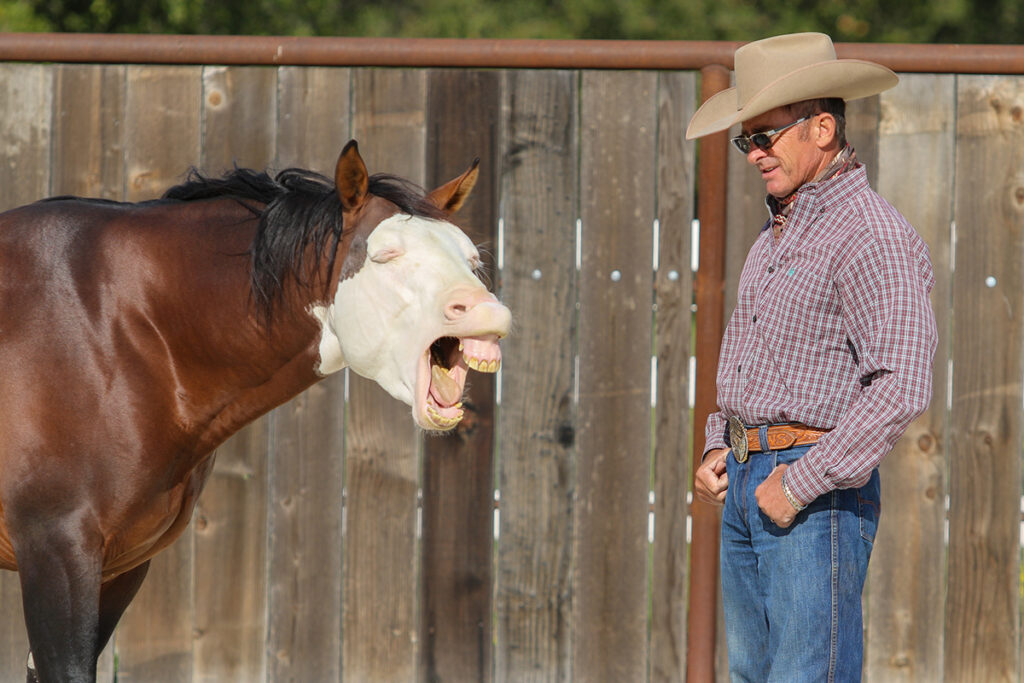
Additionally, you have communicated how aware you are of the small things. This activates the social engagement brake by giving your horse a sense of “being seen, being heard, feeling felt, and getting gotten,” which also allows you to develop trust with your horse. That trust will get you through more scary situations than any amount of desensitizing ever could. If your horse feels that you are a part of their herd security blanket, the moment something arises and you are there for them, they don’t have to engage in the other forms of brakes. Being aware of how the Parasympathetic Nervous System works allows you to choose which of your horse’s brakes you engage. It always helps to remember the saying “obedience is quicker, but the connection is better.”
This article about the polyvagal approach to desensitizing is a web exclusive for Horse Illustrated magazine brought to you in partnership with Warwick Schiller. Click here to subscribe!

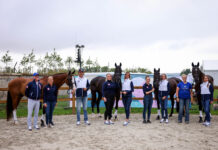


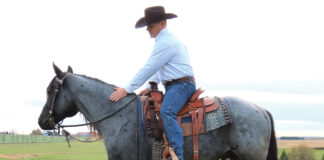

Hello
I really liked this article about Desensitizing and I am trying to work with my first horse who is a rescue and really untrained at 18 years old. I want to use Liberty work with him and have really been taking my time establishing a relationship.
I have taken my time and he lets me groom him, is very inquisitive and playful , extrovert and we have been walking , he is getting to know herd mates with a fence between, he never had other horses in his life. Very neglected.
My question is I am working on trying to desensitize him to a saddle blanket and not getting to far, he bites it, he is big and has a way of keeping his head strategically so it is difficult to get the blanket on the rest of his body. He lets me put it on his face a bit on his neck and that is it. Pressure and release , I remove it and keep trying , he does always come back but we do not get far. I let him take it off the paddock fence , lick it , put it on the ground , step on , paw it. I put it away and try again the next day. I am hoping this is the way to do it not flooding him? But then think this could take a long time…. Will I get a saddle on him at any time , and then myself??
When desensitizing I watch you tubes etc. they all do this so easy in one 15 20 minute episode.
Do you always do this at one time? or do you do this over time?
I would like to continue in Liberty training methods, continue to build a strong relationship.
I am told he was ridden years ago, I am sure he would not forget this but also not sure how positive it was, I was told he ended up with saddle sores, this was only a brief period of time. The history of this horse is vague.
Thank you
Leah